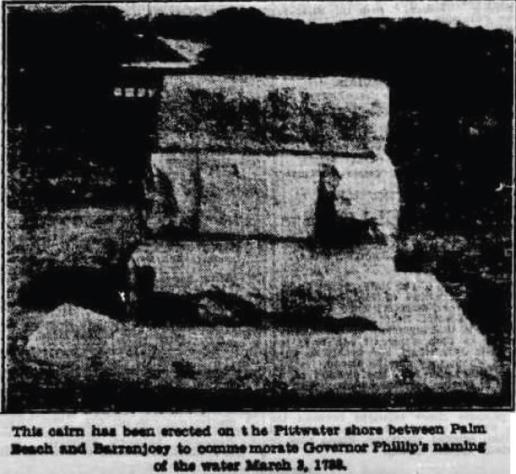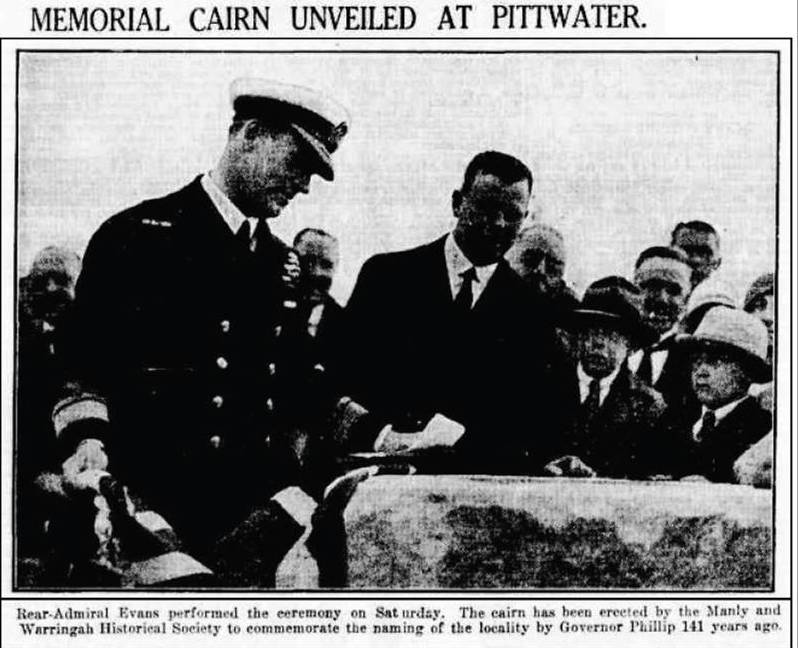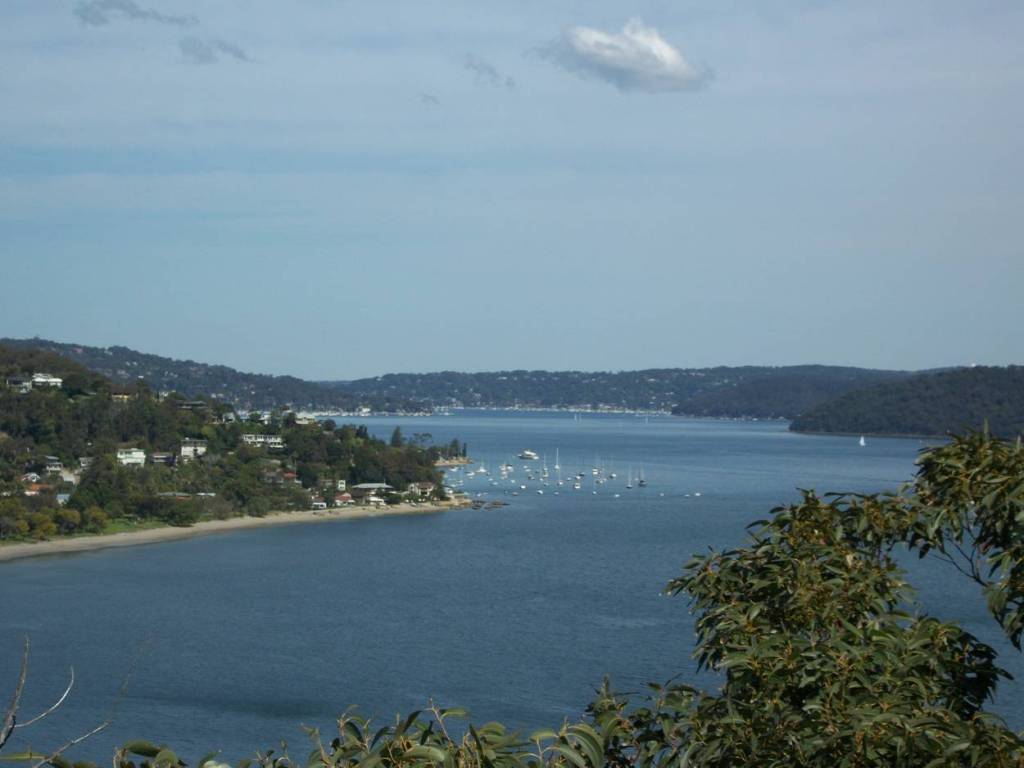January 22 - 28, 2012: Issue 42
PITTWATER. Commemorative Cairn. TO BE UNVEILED TO-DAY.
(BY G. A. KING.)
During his five years' Governorship of New South Wales, Captain Arthur Phillip played many parts. Not only was he the head of the Government of a colony thousands of miles from a base, but he was the officer commanding the naval and military forces in the new colony, and he was also the chief gaoler-the term Is used with due respect to the memory of a great man-responsible for many of the most-hardened criminals the English gaols of the day could produce. Those responsibilities would be sufficient for any ordinary man, but Phillip, a man of remarkable energy and action, found time for many other activities calculated to advance the welfare of this Greater Britain In the Southern Seas. Not the least important of these activities was his desire to become acquainted with the virgin country which surrounded the new settlement at Sydney Cove.
This afternoon, Phillip's successor in the post of officer commanding the naval forces in Australian waters-Rear-Admiral Evans will unveil a cairn at Barrenjoey to commemorate the naming of Pittwater by Phillip 141 years ago. Commendable, If tardy, recognition of the first Governor's work is at last being made, and the three principal historical societies-the Royal Australian, the Parramatta, and the Manly bodies-have of recent years erected quite a number of memorials, which, apart from their main object, exemplify the increased interest now being taken in the early history of the Commonwealth.
Admiral Evans will proceed to Barrenjoey by motor car, and as he gazes over the great expanse of water In Broken Bay, Pittwater, and Brisbane Water the thought will doubtless occur to him of the hazardous undertaking of his Illustrious predecessor, who, with his officers, explored the uncharted coastline and Inlets adjacent to Port Jackson.
PHILLIP'S ENERGY.
It Is remarkable evidence of the first Governor's unbounded energy that within six weeks of the first landing at Sydney Cove he should have had the new colony sufficiently in order to warrant him setting out on a voyage of exploration to examine what Cook, in years previously, had described as "broken land, which appeared to form a bay," and which the great navigator named Broken Bay. There is, however, a grave doubt whether the Broken Bay we know to-day is really the Inlet so named by Captain Cook, or whether the part of the coastline he referred to was In the vicinity of Collaroy and Narrabeen Lake. The distance of Broken Bay from Port Jackson as Phillip found it did not agree with that given in Cook's journal. Phillip did not comment on this discrepancy, but subsequently Flinders suggested that Cook's "broken land" was in the neighbourhood of Narrabeen Lagoon.
Phillip's examination of Broken Bay and Pittwater was the second great discovery made by him within two months of sailing into Botany Bay with the First Fleet, the units of which were coated with the sea-crust of a long and weary eight months' voyage. The first Governor had "discovered" Port Jackson, although it had been sighted and named (but not entered) by Cook; and In March, 1788, he explored and named Pittwater after William Pitt, the younger, who was then Prime Minister of England.
Fortunately for posterity Phillip left a full record of his work, and equally fortunate is it that these records, for the most part, remain Intact. "On the 2nd March," he wrote, "I went with a long-boat and cutter to examine the broken land mentioned by Captain Cook, about eight miles to the north- ward of Port Jackson. We slept In the boat that night within a rocky point In the north- west part of the bay (which Is very extensive), as the natives, tho' very friendly, appeared to be numerous; and the next day, after passing a bar that had only water for small vessels, entered a very extensive branch, from which the ebb tide came out so strong that the boats could not row against It in the stream; and here was deep water. It appeared to end In several small branches, and a large lagoon that we could not examine for want of time to search for a channel for the boats amongst the banks of sand and mud. Most of the land on the upper part of this branch was low and full of swamps. Pelicans and variety of birds were here seen in great numbers. Leaving this branch, which I called the north-west branch, we proceeded across the bay and went into the south-west branch, which is very extensive, and from which a second branch runs to the westward, affording shelter for any number of ships, and as far as we examined there is water for the largest ships, having seven fathoms at the entrance, and deep water as you go up. But the almost continual rains prevented any kind of survey. Here the land is much higher than at Port Jackson, more rocky, and equally covered with timber, large trees growing on the summits of mountains that appear to be accessible to birds only."
FIRST ENTRY TO PITTWATER.
On the same day-March 3, 1788-Phillip's party crossed Broken Bay, and he recorded that "Immediately round the headland that forms the southern entrance Into the bay there is a branch, which I think the finest piece of water I ever saw, and which I honoured with the name of Pitt Water. It Is, as well as the south-west branch, of sufficient extent to contain all the navy of Great Britain, but has only eighteen feet at low water on a narrow bar which runs across the entrance." The last-quoted phrase is eloquent of Phillip's thoroughness in examining the Inlet.
"Within the bar," continued Phillip, "there are from seven to fifteen fathoms of water. The land here Is not so high as in the south-west branch, and there are some good situations where the land might be cultivated. We found small springs of water in most of the coves, and saw three cascades falling from a height which the rains had rendered inaccessible. I returned to Port Jackson after being absent eight days in the boats. Some of the people feeling the effects of the rain, which had been almost constant, prevented my returning by land, as I Intended, In order to examine a part of the country which appeared open and free from timber."
Pittwater was the first place in Australia formally named by Phillip. The Governor apparently had a keen eye for the topography of the country, and although he did not have time during his first expedition to Broken Bay to make a thorough examination of the inlet he concluded that somewhere away In the hills (which he named Carmarthen, the Lansdowne and the Richmond Hills) there must be a large river.
From the time of Phillip's governorship, the Hawkesbury River, Broken Bay, and Pittwater have always occupied prominent places in the history of New South Wales. This afternoon's ceremony is particularly associated with Pittwater. Barrenjoey, near which headland the commemorative cairn has been erected, is at the extremity of the road from Manly, and forms the southern headland of Broken Bay. Stories of smuggling are associated with the early days of Broken Bay, and even as recently as 1870 there was a Customs House in Pittwater, just under Barrenjoey-or as It was for many years called, Barrenjuey.
Now, however, the district through which some of the earliest exploring parties travelled to reach Pittwater is a thriving pleasure and residential area, and the road from Manly to Barrenjoey Is dally thronged with streams of motor cars. Pittwater Is now almost as accessible as was Mosman in Phillip's time, but the cairn at Barrenjoey will remind the pleasure-seeker of the debt due to Phillip and his officers for their splendid work nearly one hundred and fifty years ago.
The cairn is a simple monument, and bears the following inscription:-"Erected by the Manly, Warringah, and Pittwater Historical Society to commemorate the naming, of Pitt-water by Governor Phillip on 3rd March, 1788. A.D., 1929. W. H. Ross, president; P. W. Gledhill, hon, sec."
PITTWATER. (1929, September 28). The Sydney Morning Herald (NSW : 1842 - 1954), p. 13. Retrieved January from http://nla.gov.au/nla.news-article16588226

View of Pittwater Picture from Newspaper: VIEW OF PITTWATER. (1929, September 28). The Sydney Morning Herald (NSW : 1842 - 1954), p. 13. Retrieved from http://nla.gov.au/nla.news-article16588213
|
|
Governor Phillip's Barrenjoey Cairn
CAIRN ‘stone marker’ from Scottish Gaelic ‘karn’. A mound of stones erected as a marker or memorial.

Cairn Picture from Newspaper: CAIRN FOR PITTWATER. (1929, September 28). The Sydney Morning Herald (NSW : 1842 - 1954), p. 13. Retrieved from http://nla.gov.au/nla.news-article16588210
Erected beneath Barrenjoey headland, in Governor Phillip Park and unveiled on Saturday, September 28, 1929, was a marker to commemorate the naming by Governor Phillip of what we call today Pittwater.
PITTWATER MEMORIAL TO BE UNVEILED TODAY.
The cairn to commemorate the naming of Pittwater by Governor Phillip on March 3, 1788, will be unveiled at Governor Phillip Park, Palm Beach, at half-past three o'clock this afternoon by Rear-Admiral Evans.
After the ceremony the party will pay an official visit to the Barrenjoey Lighthouse. The party will then return to the Royal Motor Yacht Club, Broken Bay clubhouse, where a dinner will be held, to be followed by a dance. The Broken Bay fleet of yachts willbe lined off the cairn at Palm Beach.
PITTWATER MEMORIAL. (1929, September 28). The Sydney Morning Herald (NSW : 1842 - 1954), p. 21. Retrieved from http://nla.gov.au/nla.news-article16588259
PITTWATER. CAIRN UNVEILED. ADMIRAL PRAISES PHILLIP.
"We read of Captain Arthur Phillip as the first and greatest Governor of Australia, and today we, just one little group of his admirers, gather to pay tribute to his name by the simple ceremony of unveiling a cairn. If Governor Phillip were asked to find an expression for this particular occasion, he would probably have said in his simple, straight-forward way, 'God bless our Empire, advance Australia, God save the King,' and in the same spirit I, who am but a humble twentieth century sailor, am honoured and delighted to perform this unveiling ceremony."
In those words, Rear-Admiral Evans, commanding the Royal Australian Navy, on Saturday afternoon unveiled a cairn erected beneath the shadow of Barrenjoey headland to commemorate the naming of Pittwater by Governor Phillip on March 3, 1788. The memorial was erected by the Manly, Warringah, and Pittwater Historical Society, and the president of the society (Mr. W. L. Ross) presided at the unveiling ceremony. Many members of the society attended, and there were also present the Minister for Works (Mr. Buttenshaw), Mr. Archdale Parkhill, the Chief City Commissioner (Mr. Garlick), Mr. P. W. Gledhill (honorary secretary of the Manly Historical Society), and representatives of the Warringah Shire Council, and the Manly Municipal Council.
Rear-Admiral Evans was escorted from the Broken Bay clubhouse of the Royal Motor Yacht Club to Palm Beach by a fleet of yachts, which anchored off the cairn during the ceremony.
In unveiling the memorial, Rear-Admiral Evans congratulated the Manly Historical Society, the members of which, even in these days of materialism, united in their minds and ideals the sacrifices and the splendid constructive patriotism of the sailor-explorers of the past with the aims, hopes, and purposes of today.
"Today," added Admiral Evans, "we are paying tribute to an Englishman of the pre-Trafalgar days, who helped to found dominions and who was one of the really great. In this gathering, nearly all Australians, are folk who look back upon the history of Captain Arthur Phillip's Governorship with a sense of pride and gratitude, as one of the founders of Australia that we know and love so well. Nowadays we have great ships, electric light, cooling apparatus, ice chests, and sweet water from distilling plants, with powerful engines to keep us off the rocks-we even have our own dental surgeons and cinemas on board -but the old-time sailors had none of these. They were baked alive in the sun, parched for want of water, fever-stricken in the Islands, scurvy-smitten on long voyages, and often murdered upon landing, like the valiant Captain Cook. Governor Phillip, who was one of the greater sailor-pioneers, learnt his qualities of leadership and sound administration in a very hard school-the school of tall masts and howling gales, whilst he learnt his patience in tropic seas and trying cairns, and like many other sailor-explorers and servants of Empire, all of his herculean courage and cheerfulness came to him from his sea training."
The party subsequently inspected the Barrenjoey lighthouse. In the evening the Admiral was entertained at dinner by the Royal Motor Yacht Club.
PITTWATER. (1929, September 30). The Sydney Morning Herald (NSW : 1842 - 1954), p. 10. Retrieved from http://nla.gov.au/nla.news-article16588598
The Manly Warringah Pittwater Historical Society, whose first speaker this year is Margaret Millar, a lady who contributed to our Remembrance Day articles in 2011, is owed a debt of gratitude by all on our Peninsula. Since 1924 the members of one of Australia’s oldest suburban historical societies have sought to communicate some of the breaths and footsteps of those who came before us.
Pittwater Online News contends that the naming occurred on 5th of March in Governor Phillip Camps On Resolute Beach.
Further:
BARRENJOEY PENINSULA.
On Saturday afternoon about 60 members of the Royal Australian Historical Society visited Barrenjoey Headland, and inspected the various spots with historical interest along the peninsula. These dated back to the time of Captain Phillip, whose naming of Pittwater had been commemorated by the erection of a cairn, the work of the ManlyWarringah-Pittwater Historical Society. This society also placed a cairn on the site of the first lighthouse on the headland, and recently erected the Gledhill Lookout on the highest point. The visitors were taken to these places and subsequently shown over the Barrenjoey lighthouse.
BARRENJOEY PENINSULA. (1935, October 28). The Sydney Morning Herald (NSW : 1842 - 1954), p. 5. Retrieved from http://nla.gov.au/nla.news-article17220905
NB: Gledhill Lookout/Cairn was made from original lighthouse sandstone.
BARRENJOEY LIGHTHOUSE.
Historic Visitors' Book.
Stiff-limbed old men, grey-haired women athletic Girl Guides and youths climbed the precipitous heights of Barrenjoey on Saturday afternoon to witness the official handing over of the lighthouse visitors' book to officials of the Manly-Warringah and Pittwater Historical Society.
On August, 13 1932, the light was converted to the automatic system, and from then no keeper has been on the station Saturday's was consequently the last public inspection of the lighthouse, which has attracted 19,000 people since 1881
It was in a spirit of sadness that the visitors on Saturday signed the book and slowly filed up the stairs. Many found interest in the gaunt brick building which housed the lighthouse keeper, and is now deserted, a departmental "to-let" notice adorning the front window.
Captain M J Lowe (president of the Manly Warringah-Pittwater Historical Society, said that the society was determined to leave no stone unturned in keeping matters of historical Interest before the public
The Minister for Commerce (Mr Stewart), in handing over the book praised the work of the society
The secretary of the society (Mr W Gledhill) read an interesting paper on the history of the lighthouse. This revealed that it was erected in 1881 at a cost of £16,695 The man responsible for the establishment in 1807 of a permanent beacon light at Barrenjoey was Mr R Stewart, M L A. During the erection of the present structure, two men lost their lives.
Captain Williams, deputy director of navigation and lighthouses said that the new light required nothing more than daylight to operate the sensitive valve controlling the functioning of the light
In future the visitors' book will be available for inspection at the Manly Art Gallery,
BARRENJOEY LIGHTHOUSE. (1933, March 27). The Sydney Morning Herald (NSW : 1842 - 1954), p. 8. Retrieved from http://nla.gov.au/nla.news-article16965450
|
Cairn Unveiling Pic: PITTWATER. (1929, September 30). The Sydney Morning Herald (NSW : 1842 - 1954), p. 14. Retrieved from http://nla.gov.au/nla.news-article16588598 Pittwater Estuary from Barrenjoey Headland 2012:
|

